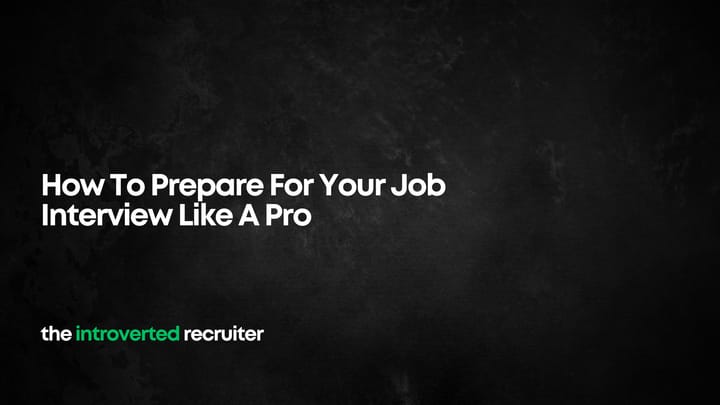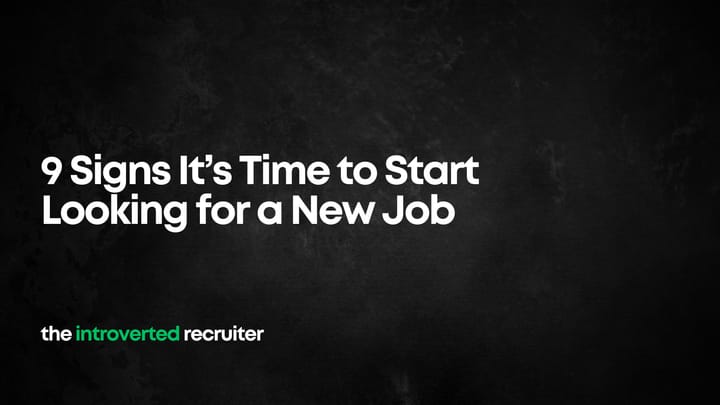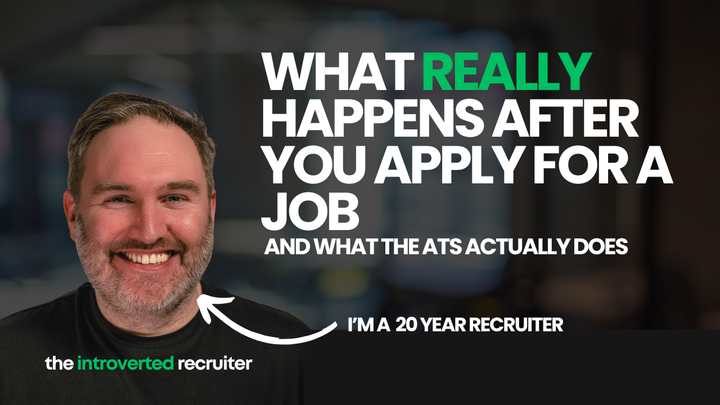The Hidden Job Market: How to Access Jobs That Aren’t Advertised

Job hunting sucks. Let’s just be honest about it. It’s exhausting, frustrating, and feels like a black hole most of the time. You send out your CV, click “apply,” and then you wait—sometimes for a response that never comes. But what if I told you that you’re probably focusing on the wrong thing?
Here’s the deal: some of the best jobs aren’t even advertised. In fact, my last three jobs, including my current one, weren’t advertised. I never applied for any of them.
We’re talking about that hidden job market—the roles that are filled quietly through networks, referrals, and internal hiring, without ever making it to a job board.
Why? Simple. Hiring managers and recruiters are getting hammered by the flood of applications they get through tools like LinkedIn’s ‘Easy Apply’ or AI systems that let people blast off their CVs to 100 roles in a matter of seconds. Most of those applications are irrelevant or half-baked, so recruiters just can’t be bothered. They’d rather go through someone they trust, like a referral, or pick someone they’ve already got on their radar.
And that’s where you come in. If you can get access to that hidden job market, you’ll be one of the few candidates, not one of the hundreds. And guess what? I’m going to show you how to do just that.
Why the Hidden Job Market Exists
First, let’s get into the why. Why would companies avoid advertising their roles when there are so many people looking for work? There are a few reasons, and most of them make total sense once you see how hiring really works behind the scenes.
1. Confidential Hires
This one’s pretty straightforward. Companies sometimes need to keep their hiring plans quiet. Maybe someone’s getting replaced (but doesn’t know it yet), or they’re bringing someone in for a strategic role they don’t want to announce publicly just yet. Posting those jobs online would just blow their cover.
2. Internal Referrals and Promotions
Companies love hiring from within. It’s faster, cheaper, and safer than bringing in someone from the outside. Plus, if one of their employees says, “I know a guy who would be perfect for this,” that’s way more appealing than sifting through 500 applications from total strangers. They already trust the recommendation.
3. Recruiters Don’t Need to Post
More and more companies are using recruiters and headhunters to find candidates. The thing is, these recruiters usually already have a pipeline of candidates. They’re not sitting around waiting for people to apply—they’re going out and finding the talent. That means those jobs never get posted because recruiters are already reaching out to the right people directly.
4. The Application Avalanche
Here’s the reality: tools like LinkedIn’s ‘Easy Apply’ and other AI-driven systems have made it way too easy for people to fire off applications to dozens of jobs with zero effort. Most of those applications? Not even relevant. That’s why companies are steering clear of public job posts. It’s just easier to avoid the flood and stick to more controlled hiring methods—like referrals, internal networks, and recruiters.
The Benefits of Accessing the Hidden Job Market
Now you’re probably asking, “Why should I bother with this hidden job market?” Well, because the odds are way better. Here’s why:
1. Less Competition
When a job isn’t advertised, far fewer people know about it. You’re not competing with hundreds of other candidates—you’re competing with maybe a handful. Imagine the difference in your chances when you’re one of ten people in the running versus one of five hundred.
2. Better Opportunities
Here’s the kicker: a lot of the higher-level or more desirable roles are the ones that never get posted. These are the jobs that companies fill through trusted networks. If you’re only looking at job boards, you’re probably missing out on the roles that could actually take your career to the next level.
3. Build Real Relationships
Unlike sending out your CV and praying for a response, tapping into the hidden job market is all about building relationships. That means the connections you make are valuable, not just for the job you’re trying to get right now, but for your career in the long run.
How to Leverage Your Network
So, how do you even get into this hidden job market? The first step is to work your network. I’m not talking about spamming people on LinkedIn. I mean genuinely building and maintaining relationships with the people who can help you.
1. Weak Ties Are Key
Forget your best mates or your close colleagues—those aren’t the people who are going to open doors for you. It’s the “weak ties”—the people you used to work with, acquaintances, or people you don’t know super well. These are the people who can get you access to opportunities you wouldn’t otherwise hear about.
2. Strengthen Existing Relationships
Make it a point to stay in touch with former colleagues, managers, and even clients. Send them a message on LinkedIn every once in a while, engage with their posts, and keep that connection warm. The last thing you want is to ask for help out of nowhere when they haven’t heard from you in years.
3. Reconnect the Right Way
When you do reach out, don’t make it about what they can do for you right away. Catch up. Ask how they’re doing. Show genuine interest. If the conversation naturally turns to your job search, great. If not, leave it for another time. The goal here is to stay on their radar in a positive way, not to come across as someone just looking for favors.
Building a Personal Brand That Attracts Hidden Opportunities
One of the best ways to tap into the hidden job market without even trying? Build a personal brand that makes people come to you. Sounds like BS, but it’s true. If you’re known for something—whether it’s your expertise in a certain area or just being a solid, reliable professional—you’ll start attracting opportunities.
1. Be Visible
You can’t hide in the shadows and expect opportunities to find you. You need to be active, whether it’s on LinkedIn, industry forums, or even speaking at events. Share your insights, post your thoughts on industry trends, and let people know what you’re up to.
2. Showcase Your Expertise
If you’re good at something, show it off. Whether it’s by writing articles, giving talks, or just posting regularly on LinkedIn, you need to position yourself as a go-to person in your field. The more visible and active you are, the more people will start to see you as someone they want to work with.
3. Use Recommendations to Your Advantage
Get former colleagues, clients, or bosses to write you a recommendation on LinkedIn. These serve as social proof and show recruiters or potential employers that you’re the real deal. Plus, recommendations can sometimes do the talking for you, landing you in the hidden job market without even trying.
Proactive Outreach: How to Approach Companies Directly
Sometimes, you need to go straight to the source. Waiting for jobs to come to you isn’t always an option. Here’s how you can proactively reach out to companies, even if they’re not advertising roles.
1. Do Your Homework
Make a list of companies you’d love to work for and start doing some research. What are they up to? Are they growing? Have they recently launched new projects? These are all signs they might be hiring soon, even if they haven’t posted any jobs yet.
2. Find the Decision Makers
You’re not applying through an HR portal here. You want to connect with the people who actually make the decisions— internal recruiters, department heads, hiring managers, or even the CEO, depending on the size of the company. LinkedIn is your best friend for this.
3. Send a Direct Message
When you do reach out, keep it short and sweet. Don’t send your whole life story. Just introduce yourself, explain why you admire the company, and suggest a brief chat to explore opportunities. Keep it low-pressure and focused on them, not you.
Working with Recruiters and Headhunters
Now, let’s talk about recruiters. These folks often have access to jobs that are never advertised. They’re hired by companies to fill roles quickly, and they’re looking for the right candidates before the job even hits a job board. If you can get yourself on their radar, you’ll be in a good spot to tap into the hidden job market.
1. Build Relationships with the Right Recruiters
Not all recruiters are created equal. Some specialize in certain industries or job levels, so you want to connect with the ones who are actually relevant to your field. If you’re an IT specialist, for example, there’s no point building a relationship with a recruiter who focuses on marketing roles. Do your homework, find the recruiters who work in your industry, and reach out to introduce yourself.
2. Keep the Connection Warm
Here’s the trick with recruiters: you don’t want to disappear until you’re desperate. Stay in touch, even when you’re not actively looking for a job. A quick check-in every few months can go a long way in keeping you top of mind when the right role comes along.
3. Be Proactive
If you know a recruiter who works in your field, don’t wait for them to reach out to you. Be proactive. Send them a message introducing yourself, tell them what kind of roles you’re looking for, and attach your CV. Recruiters love candidates who know what they want and are clear about their goals—it makes their job easier.
4. Use LinkedIn’s 'Open to Work' Feature Strategically
LinkedIn’s ‘Open to Work’ feature is a good tool, but you’ve got to use it smartly. Set it so only recruiters can see it—no need to broadcast it to your entire network, especially if you’re currently employed. This little toggle can help you get noticed by recruiters without tipping off your current boss. Or feel free to use the Open To Work banner if you are openly/publicly looking for work.
Networking at Industry Events: Tapping into Offline Opportunities
It’s easy to think that everything happens online these days, but there’s still a lot of value in good, old-fashioned, in-person networking. Whether it’s industry conferences, meetups, or local business events, face-to-face interactions can open doors you didn’t even know were there.
1. Why In-Person Networking Matters
In-person networking has a level of connection you just don’t get online. People are more likely to remember you, and you can make a stronger impression. Plus, you get to skip the noise of job boards and go straight to building real relationships with decision-makers.
2. How to Prepare for Networking Events
Before you go to any event, do your homework. Find out who’s going to be there, what companies will be represented, and who you might want to talk to. It’s way easier to walk into a room with a plan than it is to just show up and hope for the best. You don’t need a full-on strategy, but at least know who you’re hoping to meet.
3. Focus on Asking Questions
Networking isn’t about handing out your CV to everyone in the room—it’s about building relationships. Ask people about their work, their challenges, and their experience. People love to talk about themselves, and if you’re genuinely interested, you’ll leave a lasting impression.
4. Have Your Elevator Pitch Ready
When someone inevitably asks, “So, what do you do?” you want to have a clear, concise answer ready. Think of it as your elevator pitch—a quick sentence or two that sums up what you do and what you’re looking for. You don’t need to overthink it. Just be clear and confident.
5. Follow Up
After the event, don’t disappear. Send a follow-up message on LinkedIn or email within a few days. Mention something specific from your conversation to jog their memory and build on the connection. Here’s an example:
“Hey [Name], great meeting you at [Event]! I really enjoyed our chat about [specific topic]. Let’s stay in touch—I’d love to keep the conversation going.”
Creating Opportunities with Informational Interviews
If you’ve never tried setting up informational interviews, you’re missing out on one of the most underused tools for breaking into the hidden job market. Informational interviews are all about gathering insights and building relationships, not asking for a job directly—but sometimes they lead to opportunities you wouldn’t have found otherwise.
1. What is an Informational Interview?
An informational interview is a low-pressure conversation where you reach out to someone in your industry to learn more about their role, company, or career path. It’s not about asking for a job—it’s about building a connection and getting insights that could help you in your job search.
2. How to Ask for an Informational Interview
Keep it simple and genuine. Reach out via LinkedIn or email, introduce yourself, and ask if they’d be open to a 15-minute chat about their role or industry experience. Here’s an example of what to say:
“Hi [Name], I’ve been following your work at [Company], and I’m really interested in learning more about [specific area of interest]. I’d love to hear about your experience and any advice you might have for someone looking to break into the field. Could we set up a quick chat sometime next week?”
3. Making the Most of the Meeting
Come prepared with thoughtful questions. Ask about their career path, what they like about their job, what challenges they face, and what advice they have for someone in your position. And listen—don’t just talk about yourself the whole time. The goal here is to learn, not to pitch yourself for a job (at least, not yet).
4. Turning Informational Interviews into Job Leads
Here’s the thing: sometimes, just by having these conversations, you’ll naturally come up in future discussions about hiring. If they know you’re capable and that you’re interested in new opportunities, they might think of you when a role opens up. And even if nothing comes of it immediately, you’ve just built a relationship that could pay off down the road.
Staying Persistent: How to Handle Rejection and Keep Momentum
Let’s be real for a second—this isn’t some magic formula that guarantees you’ll land a job tomorrow. You’re going to face rejection, and some opportunities might not pan out. But that’s part of the game. The key is staying persistent without losing steam.
1. Managing Your Expectations
Not every lead is going to turn into a job offer. Sometimes, even after you’ve built a great connection, the timing isn’t right or the role goes to someone else. And that’s okay. Don’t let it knock your confidence or derail your search.
2. Turn a 'No' into a 'Maybe Later'
If a role doesn’t work out, don’t just walk away. Keep the door open by staying in touch. Thank them for considering you, and ask to stay connected for future opportunities. A polite follow-up a few months down the line can keep you top of mind when a new role opens up.
3. Keep Track of Your Progress
When you’re working the hidden job market, you’re juggling a lot of conversations, follow-ups, and connections. Use a simple spreadsheet or tracking tool to keep tabs on who you’ve spoken to, when you last followed up, and what the outcome was. Staying organized helps you keep the momentum going and ensures no opportunities slip through the cracks.
Conclusion: Your Key to Unlocking the Hidden Job Market
The hidden job market is where the real opportunities lie, but accessing it takes more than just firing off CVs and hoping for the best. It’s about building relationships, being proactive, and positioning yourself as the kind of candidate people want to hire—even before there’s a job opening.
Here’s what you need to remember:
- Be strategic with your networking. Build genuine relationships, both online and in-person.
- Keep your personal brand strong and visible. Let people know who you are and what you bring to the table.
- Stay persistent. You’re going to face rejection, but that’s all part of the process. The right opportunity will come.
The hidden job market isn’t just some mythical place—it’s real, and with the right approach, you can break into it. It might take time and effort, but trust me, it’s worth it.
Now go out there, and start making those connections.
The No-Nonsense Job Search System
** 75% exclusive discount for my newsletter subscribers (yes you!) for a limited time **
If you're tired of applying with no results, my No-Nonsense Job Search System will show you exactly how to write a standout CV, optimise your LinkedIn, master interviews, and negotiate your salary with confidence—without wasting months stuck in job search limbo.
🎓 Join now and get my Job Search Mega Bundle FREE! → Click here to enroll
Resources
- Get my £1 CV & Cover Letter Templates
- Get a copy of my ebook, The No-Nonsense Job Search & Career Playbook —packed with straight-talking advice, insider tips, and practical steps to help you land the job you want and thrive in your career. No fluff, no gimmicks—just everything you need to take control and get results. Grab your copy now
My LinkedIn Playbook
In "The LinkedIn Playbook: The No-Nonsense Guide To Building Your Personal Brand.", I’ll walk you through the exact steps I used to grow my LinkedIn following to over 60,000 and rack up more than 28 million post impressions in just 12 months. No gimmicks, just simple, proven strategies that actually work.
33% Limited Time Discount. Get it whilst you can.
Follow Me
Find me on LinkedIn , TikTok , YouTube or Instagram where I share lot’s of practical no nonsense advice.



